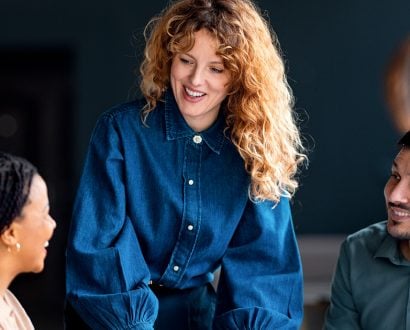While the idea of design was traditionally associated with physical objects, it has since become the norm among tech companies to create a better user experience for people using their software. It is now common to find it incorporated into whole corporate strategies.
Design thinking takes into account people’s whole experience – their interests, behaviours and needs – when coming up with a new idea.
Design thinking takes into account people’s whole experience – their interests, behaviours and needs – when coming up with a new idea.
Tim Brown, CEO of human-centred design company IDEO, says it requires curiosity, empathy and optimism.
Brown highlights that when you are trying to solve a problem, you should not assume you know the answer, as you are usually not the customer.
“Look at the experience of people through their eyes,” he says. “And the insights you get from that, you need to be able to lift those up in order to help you decide: What might be the problem we’re really trying to solve?
“Let’s say you’re studying why people in villages don’t have bank accounts. Is it because the banks aren’t in the villages, or because people don’t trust the system? If they don’t trust the system, what might you design that starts to build trust?”
When Airbnb faced financial difficulties a year after it was launched, it searched frantically to identify the cause. What the team found was that a lot of photos for listings were not good quality, which impacted bookings.
“It actually wasn’t a surprise that people weren’t booking rooms because you couldn’t even really see what it is that you were paying for,” co-founder Joe Gebbia told First Round Review.
The team, which was only three at the time, then flew to New York and upgraded the images with more visually striking ones. Within a week, the better images doubled the company’s revenue, signalling the use of design thinking.
Algarytm identifies the business benefits of design thinking to, saying it can result in higher profits, more innovation, better identification of problems and the opportunity for enhanced brand loyalty.
Companies such as IBM have even established their own design thinking centres to find more creative solutions to customer problems.
3 examples of design thinking being put into practice
- MassMutual – Society of Grown Ups
Massachusetts Mutual Life Insurance Company (MassMutual) partnered with IDEO to establish a program to get under 40 year olds to buy life insurance. The program, called the Society of Grownups, provides courses, tools and advice to assist with saving, budgeting and planning for retirement.
It acknowledges that there is no ‘one size fits all’ strategy to financial management, and instead focuses on helping its clients reach their own personal goals.
- Industrial Facility – Braun/Oral B electric toothbrush
The team at design company Industrial Facility were given the challenge of creating a better experience with the Braun/Oral B electric toothbrush.
Instead of looking at the client’s idea of tracking a user’s brushing performance, the company looked at the main frustrations the end customers had. These included forgetting to purchase replacement brush heads and the toothbrush running out of power.
As a result, Industrial Facility created toothbrushes with charging capabilities. The toothbrushes were also fitted with a button that users could press that would send a reminder to their smartphone to purchase a replacement.
- Thomas Jefferson University Philadelphia – CareCube
The university’s Health Design Lab – made up of doctors, nurses and medical students – created CareCube, a pain scoring system for paediatric wards. Traditionally, children would rate their pain levels on a scale of one to 10. However, the lab’s healthcare workers identified that toy objects would be more helpful.
Each side of the cube has different facial expressions such as a grimace or a frown. When a child is asked how much pain they feel, they can simply point to the face on the cube as a better indication for nurses.
Our OH! #IoT Toothbrush for #Braun #OralB is at #wallpaperhandmade during #milandesignweek https://t.co/RT5dHFbITw pic.twitter.com/2yA68NhLpa
— Industrial Facility (@industrialfacil) April 15, 2016







